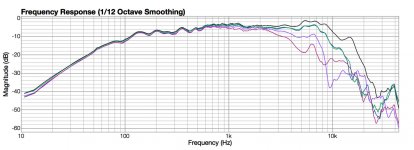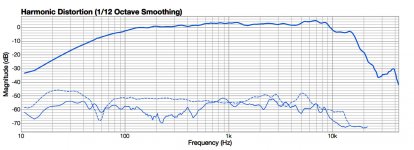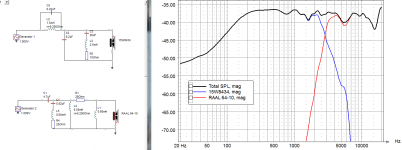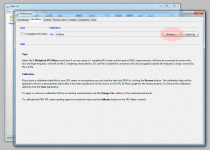Just know this ... I did not choose any forum member's suggestion over the other due to their technical points and counter points in this thread.
Because I couldn't understand ANY of them at all !
-that's ok. 😉 😀
I am however a bit worried about the result of the design vertically at a close listening distance with a recommended "3.5 kHz" and the midbass you've chosen. 😱
I'm assuming Zvu has this covered and will fill in detail here.
Haven't read all the posts here, but adding my 2cents.
If you want a simple crossover, consider using a full range driver mated with the Raal.
Zu Audio use this technique on their speakers.
If you want a simple crossover, consider using a full range driver mated with the Raal.
Zu Audio use this technique on their speakers.
Please explain the "3.5 kHz" (your reasoning).
Tweeter sounded a bit strained at 3KHz but it sounded cleaner little higher.
The "resonance" from about 1.3 to 1.9 kHz, is a surround diaphragm issue (anti-phase alteration, NOT a typical "bell mode" resonance). It's also low in amplitude as it is, more than 20 db at the most substantive ridge (almost a millisecond in) at 1.9 kHz. (..the sonogram is remarkably clean in bandwidth relative to the average.) Practically speaking it's a NON-issue.
For lots of guys it is a non issue - for me it is. The most negative example is Satori with its surround resonance on otherwise great midwoofer. If there are drivers without surround resonance why should i choose the one that has it ?
We should be looking at linear distortion, but it's a matter of what we are looking for. In particularly we should be concentrating on near time and near average pressure deviance's, and most particularly on deviance's that span a very narrow bandwidth and are above the average *after correction*.
In the Audax's case it's the amplitude change at about 3.8-3.9 kHz, that's most troubling (near average and half a millisecond in spanning a narrow bandwidth). However, the linearity of the driver will be altered and will be suppressed both in amplitude AND time with a good filter and well-summed tweeter.
.
Here too i may say - why should i choose the driver with some issues so close to crossover frequency if i can choose the one without it or much further ?
Other than that, Audax has Fs at 150Hz so it is hardly for 2 way monitor.
These are on the way as of now ...
Scan-Speak 15W/4524T02 Limited Edition Woofers
Two of them, if you must know! 😀
@ Zvu .... Here I have been telling you things I kave learned about the 64-10, and I just now read a post where you have designed with it before.
I feel pretty dumb now, LOL.
Great choice. Jon Marsh measured stellar performance for a small midwoofer such as that - and at that price i dare to say that they look better than ZA14 on paper.
I did some work with 15W4434 and 64-10. It sounded Ok but since it was meant to be listened farfield, of-axis was an issue when i made crossover point at 3500Hz. That's why i suggested 4" TB or 4" SBacoustics - later on they can be used as a midrange/tweeter combination for a three way with the right woofer.
But, if it is to be listened nearfield, then you shouldn't notice any negative effects by making the crossover a bit higher than usual for a 5" midwoofer.
Last edited:
Tweeter sounded a bit strained at 3KHz but it sounded cleaner little higher.
For lots of guys it is a non issue - for me it is. The most negative example is Satori with its surround resonance on otherwise great midwoofer. If there are drivers without surround resonance why should i choose the one that has it ?
Here too i may say - why should i choose the driver with some issues so close to crossover frequency if i can choose the one without it or much further ?
Other than that, Audax has Fs at 150Hz so it is hardly for 2 way monitor.
I did some work with 15W4434 and 64-10. It sounded Ok but since it was meant to be listened farfield, of-axis was an issue when i made crossover point at 3500Hz. That's why i suggested 4" TB or 4" SBacoustics - later on they can be used as a midrange/tweeter combination for a three way with the right woofer.
But, if it is to be listened nearfield, then you shouldn't notice any negative effects by making the crossover a bit higher than usual for a 5" midwoofer.
I'm guessing the strained result was also substantively more than a meter in distance listening - with the attendant loss in pressure. It's a guess, but I suspect that in the near-field it won't be much of an issue (with a higher spl for a given input level). Of course it depends on use (..if it's needed for extreme spl's then it might well be an issue).
How do you know the surround resonance of the Audax is an issue? Just because you don't like the way it looks? I get wanting better if it's available assuming all-else is equal, but it really never is. Is the Satori audibly objectionable because of this? Might it have enough other redeeming AUDIBLE features that more than compensate assuming their is a minor audible problem related to its surround? (..and that's a BIG assumption.)
(..and yeah, I understand the the Audax is strictly a mid.. reading the first post doesn't mention the necessity of 2-way design, rather it specifically says's: "How would YOU go about building a pair of computer monitors under these situations ?". It's also why I mentioned the Dayton Audio midbass in conjunction with the Audax.) 😉
BTW, I discounted the Satori's for their size/diameter and their efficiency relative to the RAAL and it's higher crossover. I'd do the same for the Scanspeak, particularly with a "near-field" (studio) design. (..not meaning to be harsh (truly): but your last statement is absolutely wrong.) 😱
-and that underlies the problem.
Looking at a small surround resonance so suppressed in amplitude is a minor and likely INaudible problem.
On the other hand:
Neglecting directivity problems just above the crossover region for a "near-field" monitor is a BIG problem, and is absolutely going to be audible (..particularly with even minor listener head movements).
-it's a matter of priority.
My guess is that for this two-way (with the two chosen drivers): a LOT of crossover work is going to have to occur to achieve anything resembling good. 😱 (..and based on the poster's comments, I'm guessing that this isn't his forte.)
Last edited:
I'm guessing the strained result was also substantively more than a meter in distance listening - with the attendant loss in pressure. It's a guess, but I suspect that in the near-field it won't be much of an issue (with a higher spl for a given input level). Of course it depends on use (..if it's needed for extreme spl's then it might well be an issue).
It was at about 2 meters but i will not try to guess how will it act from a meter away. Flaxxer is going to tell us.
...
How do you know the surround resonance of the Audax is an issue? Just because you don't like the way it looks? I get wanting better if it's available assuming all-else is equal, but it really never is. Is the Satori audibly objectionable because of this? Might it have enough other redeeming AUDIBLE features that more than compensate assuming their is a minor audible problem related to its surround? (..and that's a BIG assumption.)
How do you know it isn't ?
Yes, just because i don't like how measurement looks and because i would never buy a driver just to see if it sounds as bad as it measures. Pass-band absolutely MUST be as clean as possible - otherwise you've just chosen to make another compromise, with the ones that you have to make already.
BTW, I discounted the Satori's for their size/diameter and their efficiency relative to the RAAL and it's higher crossover. I'd do the same for the Scanspeak, particularly with a "near-field" (studio) design. (..not meaning to be harsh (truly): but your last statement is absolutely wrong.) 😱
-and that underlies the problem.
Looking at a small surround resonance so suppressed in amplitude is a minor and likely INaudible problem.
On the other hand:
Neglecting directivity problems just above the crossover region for a "near-field" monitor is a BIG problem, and is absolutely going to be audible (..particularly with even minor listener head movements).
-it's a matter of priority.
There are too many guesses in your post but there might be a chance that you are right and i am wrong. He just might be jumping arround on his chair in front of his computer or move his head 30cm left and right every half second. On the other hand, i listened similar combination of drivers nearfield and farfield and worked with them for some time. Crossover was quite simple. Even with RAAL's recommended crossover (at 3100Hz) there was not any visible problem in off axis response, and his recommended crossover is for durability - nobody says that we can not use bigger capacitor and lower crossover a bit for a strict nearfield. There was a slight dip that was quite narrow and shallow (about 2dB) at 45 deg with 3500Hz crossover - at 3200Hz there was no dip, as can be seen on my HTguide post. The only reason i had to make it 3500Hz is because the owner wanted to listen to it a little louder than usual and i wanted to protect the tweeter. Off axis wasn't a real issue but better tweeter came up for ridiculous amount of money and he sold 64-10 and bought bigger ribbons that can be crossed much lower.
You'll just have to accept that set of compromises that you find acceptable is not the best set of compromises as you try to make it look. SB12CAC that i proposed looks good but this little ScanSpeak (judging by its close relative 15W that i've worked with) will work just as good and be probably much easier to tame with crossover.
My guess is that for this two-way (with the two chosen drivers): a LOT of crossover work is going to have to occur to achieve anything resembling good. 😱 (..and based on the poster's comments, I'm guessing that this isn't his forte.)
Your first guess in this part of the quote is wrong. Other guess, well - nobody is beating you to help. I will because i enjoy it and somehow i think i'll manage.
Cheers
Last edited:
How do you know it isn't ?
Yes, just because i don't like how measurement looks and because i would never buy a driver just to see if it sounds as bad as it measures. Pass-band absolutely MUST be as clean as possible - otherwise you've just chosen to make another compromise, with the ones that you have to make already..
Guesses, yes - but reasonable and based on experience. I use QUALIFIED caveats because there are always going to be exceptions - that's just life. 😉
There might well be someone out there (..maybe you?, don't know) that is particularly sensitive to even the slightest surround resonant issue. I've never come across such a person to my knowledge; everyone I've met personally who I've introduced to a variety of drivers/loudspeakers with a very slight surround issue has never had a problem with it (..and in fact I've introduced several fullrange drivers that had *more* than a little problem with this - and still no reaction negative or otherwise). Moreover Psychoacoustic research doesn't support such a position. (..just like it doesn't support hearing 2nd and 3rd order non-linear distortion being audible below a few percent at a reasonable spl and distance.)
Most drivers have a bit of surround issues - and I've heard a LOT of drivers in a LOT of designs. I've heard that Audax driver, I have had the pro 6" paper, I still have the pro 6" aerogel. They all have this problem and it really isn't audible.
..and here is the "kicker":
The ScanSpeak 15W/4524T-02 clearly has the same problem, it's just a little lower in freq. because the driver has a larger diameter.
-and everything is a compromise, it's more a matter of choosing what is more important to a successful design (in the context of loudspeaker design), though generally as well.
You'll note that I don't have a problem with the ScanSpeak's surround resonance. Would I prefer it not be there? Sure. Because like you I'd prefer a more "perfect" driver. But it's not something I'd place so much emphasis and priority on this instance.
Attachments
He just might be jumping arround on his chair in front of his computer or move his head 30cm left and right every half second.
Surely and exaggeration. 😛 😀
Do note though: as you get closer to the loudspeaker, you hear more of the off-axis response (a lot more - and the diffraction signature becomes more prominent).
..and as I've alluded to before, it's not so much the "side-to-side" that bothers me.
Instead it's the verticals. (..think that one over a bit, or better - model it.)
And it's not just the vertical with any "near-field" design, it's one with:
1. a line source and a point-source,
2. a higher crossover freq. and a faster slope.
3. a midbass driver with a larger diameter and a more directive response at higher freq.s.
Now a possible solution (other than obviously lowering the crossover freq.) is:
-putting the ribbon BESIDE the midbass AND trimming the face-plate to get it closer to the midbass. 😉
...
..and here is the "kicker":
The ScanSpeak 15W/4524T-02 clearly has the same problem, it's just a little lower in freq. because the driver has a larger diameter.
-and everything is a compromise, it's more a matter of choosing what is more important to a successful design (in the context of loudspeaker design), though generally as well.
You'll note that I don't have a problem with the ScanSpeak's surround resonance. Would I prefer it not be there? Sure. Because like you I'd prefer a more "perfect" driver. But it's not something I'd place so much emphasis and priority on this instance.
I'm somehow sure i don't have any of the drivers you introduced and i definitely don't have any full-range in my house 🙂
Now - on the constructive side, while there might be a clue of surround resonance in ScanSpeak 15W it is dealt with in a certain manner - there are little cuts on the cone at the place where cone is glued to the surround that serve to diminish that particular resonance and also the distortion (2nd order mostly) connected to it at that frequency. Measurements of Scan-Speak 15W/4524T02 attached.
Our main concern is vertical dispersion at crossover frequency. Well, the one who has concerns of that type usually doesn't use ribbon tweeter that has 64mm long ribbon - but since the OP wants to use that particular tweeter for his desktop speakers, let us work with that constraints. 4" midwoofer wouldn't be much better in that regard at crossover frequency. But, sitting that close enables us to make some other things possible - as is lowering the crossover point for better horizontal dispersion. Here's quick and dirty 30mins of work. Xover "optimized" for 75cm listening distance. It doesn't change violently going nearer or further. Here is 01:47 at night so it's really dirty 🙂
I used the files i made long time ago of RAAL 64-10 and 15W8434 and this is full BSC but that can be easily altered by few components value changes (i've already checked it).
As for distortion audibility, i wouldn't start that here. There are few threads that led nowhere and i didn't want to take a part in them. I have my own principles that i'm guided by and one of them should be that harmonic distortion is the last thing i look, but i do look at it when i'm choosing a driver. How much is too much i really don't know so lower=better if everything else is good and equal.
Attachments
Last edited:
..Even with RAAL's recommended crossover (at 3100Hz) there was not any visible problem in off axis response, and his recommended crossover is for durability - *nobody says that we can not use bigger capacitor and lower crossover a bit for a strict nearfield.
*emphasis added.
Ah, but you've been suggesting that it should be crossed HIGHER in freq. than the 3.1 kHz (with similar filter). 😱
..and not because of "durability", but "strain" - an audible description.
Drop the crossover freq. enough and I've got no problems with the ScanSpeak's directivity. 😉
*emphasis added.
Ah, but you've been suggesting that it should be crossed HIGHER in freq. than the 3.1 kHz (with similar filter). 😱
..and not because of "durability", but "strain" - an audible description.
Drop the crossover freq. enough and I've got no problems with the ScanSpeak's directivity. 😉
RAAL suggested it for durability because it is intended to be listened farfield. Yesterday OP sent me a pm and in it was data where it is going to be used and at what distance more precisely so there is no danger if the crossover point is lower when loudspeakers can be reached by hand. They need some juice in it to be perceived as strained.
Strain or lower durability - it is quite similar to me. I think of myself as somebody that manages well enough in English but it is possible that some finesses are escaping my perception.
Last edited:

Looks decent, despite the dips.
(..I'd probably drop the "plateau" around the crossover by about a db.)
-again, a lower crossover point at a more complex filter.
OP here ... looong day! Hello everyone. Having caught up on reading here, I can offer a couple of thoughts to see if they are of any help.
The xover point ... I have NO clue if Dennis heard a chalky sound when crossed lower than 3400 at higher volumes only, or at all volumes. But My face will be no more than 33" from the face of each speaker. How much can the RAAL strain at volume levels sitting that close, if it were crossed closer to 3000? I occasionally listen loudly to dynamic music, but not for long at that distance!
As far as my skills ... they are only limited in regards to designing speakers. My soldering skills are excellent, and my woodworking is as well. I have a large and well stocked shop at my house.
That is why this is difficult for me ... I can do everything but the first step 🙄
The xover point ... I have NO clue if Dennis heard a chalky sound when crossed lower than 3400 at higher volumes only, or at all volumes. But My face will be no more than 33" from the face of each speaker. How much can the RAAL strain at volume levels sitting that close, if it were crossed closer to 3000? I occasionally listen loudly to dynamic music, but not for long at that distance!
As far as my skills ... they are only limited in regards to designing speakers. My soldering skills are excellent, and my woodworking is as well. I have a large and well stocked shop at my house.
That is why this is difficult for me ... I can do everything but the first step 🙄
I haven't heard any issues with the tweeter with only 4.7uF and 12ohm resistor untill it is quite loud - and that's farfield. Nearfield doesn't need that levels so it should work.
You must be able to make some inbox measurements if we're going to pull this off so think about getting an Umik or Dayton UMM-6 microphone.
You must be able to make some inbox measurements if we're going to pull this off so think about getting an Umik or Dayton UMM-6 microphone.
Last edited:
I haven't heard any issues with the tweeter with only 4.7uF and 12ohm resistor untill it is quite loud - and that's farfield. Nearfield doesn't need that levels so it should work.
You must be able to make some inbox measurements if we're going to pull this off so think about getting an Umik or Dayton UMM-6 microphone.
No problem. Before I purchase. will a calibrated omni directional work? I have one which came with an AVR receiver. If not, I'm purchasing a mic!
I really don't know if it will work properly or not. I don't know what's the quality of that mic and is the calibration done well.
No problem. Before I purchase. will a calibrated omni directional work? I have one which came with an AVR receiver. If not, I'm purchasing a mic!
The calibration file for the mic. is probably part of the software for the receiver. (..meaning your "calibrated" mic. isn't calibrated when used with anything OTHER than your receiver.)
You can still use it of course, but it likely won't be as accurate in the top 2 octaves and perhaps as much as the bottom 3. I don't think either will cause problems with the design work for your loudspeaker.
If you really want an integrated sound-card mic. with a calibration file you can input into the measurement program of choice (..like REW -Room Eq Wizard), then here is suitable offering:
Dayton Audio UMM-6 USB Measurement Microphone
-there only 2 real caveats I'd have with such a solution, and both are at a "Pro" level that would almost certainly be irrelevant to your needs.
The calibration file for the mic. is probably part of the software for the receiver. (..meaning your "calibrated" mic. isn't calibrated when used with anything OTHER than your receiver.)
You can still use it of course, but it likely won't be as accurate in the top 2 octaves and perhaps as much as the bottom 3. I don't think either will cause problems with the design work for your loudspeaker.
Thanks Scott. But I purchased the Umik-1, and already have RoomEQW installed.
Thanks Scott. But I purchased the Umik-1, and already have RoomEQW installed.
Same basic USB mic..

This is from an older tutorial, but it should still be applicable for the calibration file (that you download from minidsp):
Attachments
- Status
- Not open for further replies.
- Home
- Loudspeakers
- Multi-Way
- RAAL ribbon with 4" midbass computer monitors




